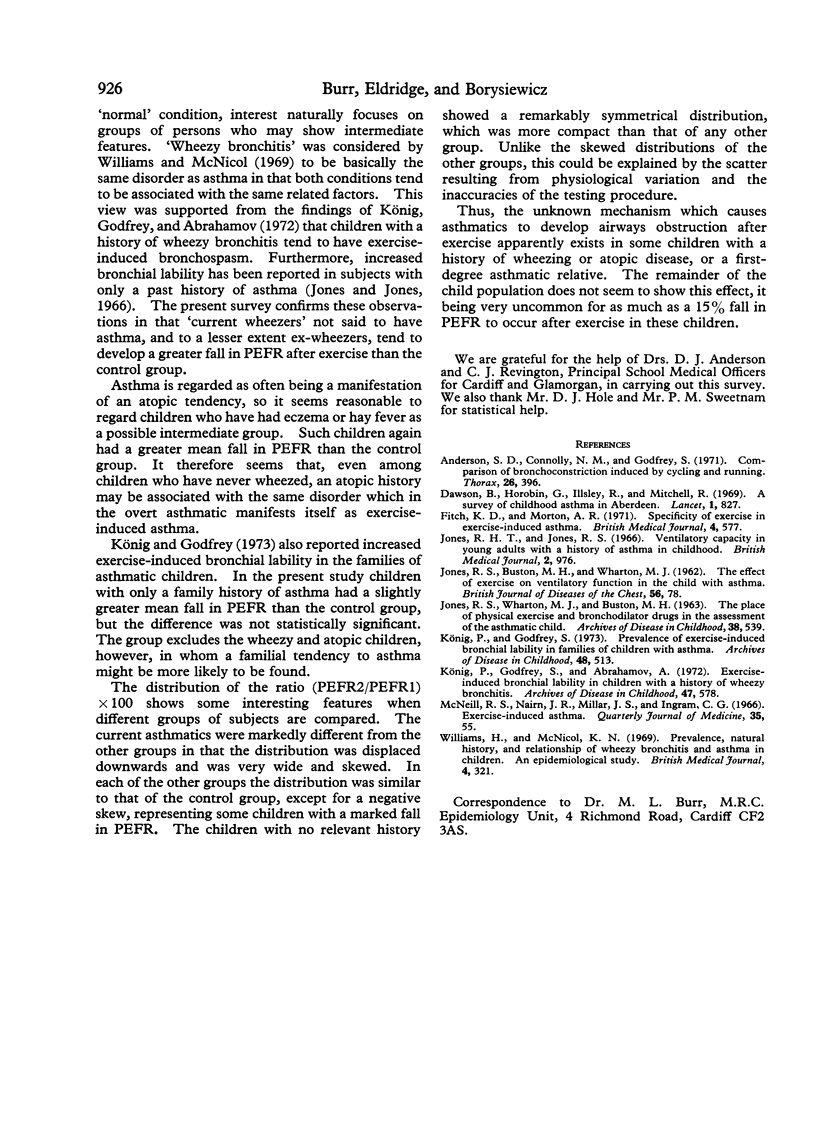Abstract
Peak expiratory flow rates (PEFR) were measured before and after 6 minutes' exercise in 12-year-old schoolchildren living in two areas. In boys, but not in girls, the mean initial PEFR was lower in asthmatics than in nonasthmatics. After exercise, children with current asthma tended to show a marked fall in PEFR. Children with a history of wheezing, atopic disease, or a first-degree asthmatic relative showed something of the same tendency, though their responses to exercise largely overlapped those of the control group.
The unknown mechanism causing exercise-induced asthma appears to operate also in some subjects who show features related to asthma, but not in the rest of the child population.
Full text
PDF



Selected References
These references are in PubMed. This may not be the complete list of references from this article.
- Anderson S. D., Connolly N. M., Godfrey S. Comparison of bronchoconstriction induced by cycling and running. Thorax. 1971 Jul;26(4):396–401. doi: 10.1136/thx.26.4.396. [DOI] [PMC free article] [PubMed] [Google Scholar]
- Dawson B., Illsley R., Horobin G., Mitchell R. A survey of childhood asthma in Aberdeen. Lancet. 1969 Apr 19;1(7599):827–830. doi: 10.1016/s0140-6736(69)92082-0. [DOI] [PubMed] [Google Scholar]
- Fitch K. D., Morton A. R. Specificity of exercise in exercise-induced asthma. Br Med J. 1971 Dec 4;4(5787):577–581. doi: 10.1136/bmj.4.5787.577. [DOI] [PMC free article] [PubMed] [Google Scholar]
- JONES R. S., BUSTON M. H., WHARTON M. J. The effect of exercise on ventilatory function in the child with asthma. Br J Dis Chest. 1962 Apr;56:78–86. doi: 10.1016/s0007-0971(62)80005-9. [DOI] [PubMed] [Google Scholar]
- JONES R. S., WHARTON M. J., BUSTON M. H. THE PLACE OF PHYSICAL EXERCISE AND BRONCHODILATOR DRUGS IN THE ASSESSMENT OF THE ASTHMATIC CHILD. Arch Dis Child. 1963 Dec;38:539–545. doi: 10.1136/adc.38.202.539. [DOI] [PMC free article] [PubMed] [Google Scholar]
- Jones R. H., Jones R. S. Ventilatory capacity in young adults with a history of asthma in childhood. Br Med J. 1966 Oct 22;2(5520):976–978. doi: 10.1136/bmj.2.5520.976. [DOI] [PMC free article] [PubMed] [Google Scholar]
- König P., Godfrey S., Abrahamov A. Exercise-induced bronchial lability in children with a history of wheezy bronchitis. Arch Dis Child. 1972 Aug;47(254):578–580. doi: 10.1136/adc.47.254.578. [DOI] [PMC free article] [PubMed] [Google Scholar]
- König P., Godfrey S. Prevalence of exercise-induced bronchial lability in families of children with asthma. Arch Dis Child. 1973 Jul;48(7):513–518. doi: 10.1136/adc.48.7.513. [DOI] [PMC free article] [PubMed] [Google Scholar]
- McNeill R. S., Nairn J. R., Millar J. S., Ingram C. G. Exercise-induced asthma. Q J Med. 1966 Jan;35(137):55–67. [PubMed] [Google Scholar]
- Williams H., McNicol K. N. Prevalence, natural history, and relationship of wheezy bronchitis and asthma in children. An epidemiological study. Br Med J. 1969 Nov 8;4(5679):321–325. doi: 10.1136/bmj.4.5679.321. [DOI] [PMC free article] [PubMed] [Google Scholar]


